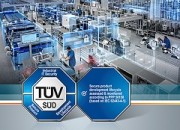 The International Society of Automation (ISA) and the ISA Global Cybersecurity Alliance have released a new guide to the world’s only consensus-based automation cybersecurity standards. “Quick Start Guide: An Overview of the ISA/IEC 62443 Series of Standards,” now available for download at isa.org/cyberguide, provides a high-level view of the objectives and benefits of these standards—as well as easy-to-use explainers on how to navigate them. The guide explores how and why IT and OT/ICS need unique types of protection against cyber threats and offers the latest recommendations on patch management. This new guide answers some of the most common questions about the ISA/IEC 62443 Standards, including:
The International Society of Automation (ISA) and the ISA Global Cybersecurity Alliance have released a new guide to the world’s only consensus-based automation cybersecurity standards. “Quick Start Guide: An Overview of the ISA/IEC 62443 Series of Standards,” now available for download at isa.org/cyberguide, provides a high-level view of the objectives and benefits of these standards—as well as easy-to-use explainers on how to navigate them. The guide explores how and why IT and OT/ICS need unique types of protection against cyber threats and offers the latest recommendations on patch management. This new guide answers some of the most common questions about the ISA/IEC 62443 Standards, including:
Why is this series of standards important? What are the benefits of using the standards?
How are IT and ICS systems different?
Which documents are part of the series and how can I use them to find what I need?
Where can I find the current best practices around patch management?
The ISA Global Cybersecurity Alliance’s Advocacy and Adoption work group coordinated the development of the guide, which was authored by Johan Nye. Nye is an independent consultant specializing in industrial control systems and cybersecurity. During his career spanning more than 38 years, Nye has designed ICS system architectures, created company standards and policies, implemented major ICS projects, supported ICS site engineers, and contributed to the design of several ICS products.
“Automation cybersecurity standards are crucial in this increasingly connected world,” says Mary Ramsey, ISA executive director. “The ISA/IEC 62443 Series of Standards leads the way as the world’s only consensus-based standards that focus on automation cybersecurity. One goal of the ISA Global Cybersecurity Alliance is to raise awareness of these standards and encourage their adoption across a wide range of industries. We are grateful to the ISAGCA Advocacy and Adoption work group and Johan Nye for distilling these standards into a user-friendly format that can be shared widely.”

 Recently, the ISA Security Compliance Institute (ISCI) has welcome the Amazon Web Services (AWS) as the latest ISCI member.
Recently, the ISA Security Compliance Institute (ISCI) has welcome the Amazon Web Services (AWS) as the latest ISCI member. The global leader in functional safety, cybersecurity, and alarm management for the process industries, exida, has introduced their Alarm Management Practitioner (AMP) Program, a new certificate program that complements the company’s existing functional safety and ICS cybersecurity certificate programs.
The global leader in functional safety, cybersecurity, and alarm management for the process industries, exida, has introduced their Alarm Management Practitioner (AMP) Program, a new certificate program that complements the company’s existing functional safety and ICS cybersecurity certificate programs. The U.S. Department of Energy (DOE), global equipment suppliers, and other stakeholders announced the establishment of the Electric Energy OT Security Profile working group hosted by the
The U.S. Department of Energy (DOE), global equipment suppliers, and other stakeholders announced the establishment of the Electric Energy OT Security Profile working group hosted by the  As the first company to receive TÜV SÜD certification based on IEC 62443-4-1 for the interdisciplinary process of developing Siemens automation and drive products, including industrial software, Siemens received the certification at seven development sites in Germany. Among other things, these sites are developing Simatic S7 industrial controllers, Simatic industrial PCs, Simatic HMI (Human Machine Systems Interface) devices for operator control and monitoring, and Sinamics drives as well as the TIA (Totally Integrated Automation) Portal engineering software. The international series of standards IEC 62443 defines the security measures for industrial automation systems, with Part 4-1 of the standard describing the requirements of the manufacturer's development process.
As the first company to receive TÜV SÜD certification based on IEC 62443-4-1 for the interdisciplinary process of developing Siemens automation and drive products, including industrial software, Siemens received the certification at seven development sites in Germany. Among other things, these sites are developing Simatic S7 industrial controllers, Simatic industrial PCs, Simatic HMI (Human Machine Systems Interface) devices for operator control and monitoring, and Sinamics drives as well as the TIA (Totally Integrated Automation) Portal engineering software. The international series of standards IEC 62443 defines the security measures for industrial automation systems, with Part 4-1 of the standard describing the requirements of the manufacturer's development process.